From The Peopling of New York City
| Jonathan's Profile
|
| Birthdate
| December 9, 1989
|
| Location
| Brooklyn, NY
|
| Birthplace
| Brooklyn, NY
|
| Neighborhood
| Canarsie
|
| Interests
| Computer Programming
Web design
Video games
Music
Politics
|
| Education
|
P.S. 279
Herbert S. Eisenberg (I.S. 303)
Edward R. Murrow High School
Brooklyn College
|
| Honors
|
National Honor Society
|
| Major
|
Business administration/Law/English
|
My Bio
My name is Jonathan Lin. I am currently a freshman at Brooklyn College. I was born in Brooklyn in the neighborhood in which i currently reside. My parents are first generation taiwanese, and their parents immigrated to Taiwan after
the communist revolution in the mid 20th century (Mother's parents from Shanghai and father's parents from Wen Zhou.)
My parents strongly believed in the public education system when they immigrated to the New York and thought that because assimilation was so difficult for them, I would be able to assimilate better into American culture if I started early. I graduated from Edward R. Murrow High School with honors.
I've always asked my parents if I was considered to be Chinese or Taiwanese. They told me that "it's not where you're born that defines who you are, it's the culture and values you hold."
My Works
In the Classroom
Perfect Utopia
The ideal community would be somewhat of a utopia and thus, never exist. The core of a community is its people. For the community to be ideal, it is essential that its people also be somewhat ideal. People must be willing to contribute daily, to help their neighbors and donate time to better the community. Also, it is essential that the people must coexist and not let differences create hostility.
Laws must be just, impartial and flexible to adjust to changing times. Like with many governments, laws should be created by a group selected directly by the people. In an ideal community, the laws must not only be accompanied with appropriate punishments for law-breakers, but they must also be made clear to everyone in the community. All arguments/offences would be dealt with peacefully in open court with a jury to determine guilt and punishment. Laws should contain specific guidelines and all cases should be based solely on the fact of that law, as to provide the fairest trial possible.
It is essential that law enforcement is fair and uncorrupted. Government must work to serve the people and better the community while remaining impartial, without corruption or fulfillment of personal agendas. Government would regulate much of business to protect consumers from unfair practices and prices. However, government exists in business solely to regulate on behalf of the consumer. They should not control nor favor any particular business. Religious establishments (churches, temples, etc.) must be kept separate from government. Government should not be permitted to advocate or denounce any religion.
Education is essential. To provide the best education, teachers must be qualified and enthusiastic. Schools must be funded with the money and materials required for a proper education where students receive the individualized attention they need. Also, it is imperative that students receive a well-rounded education where they can actively participate in the community.
Sanitation is of utmost importance. A common measure of the quality of a community is its living conditions. Along with government aid for the impoverished, thorough daily cleaning of the streets is necessary to maintain the overall health of the community. Each member of the community must be consciously aware of their actions and its effect on the community, especially littering and noise pollution.
The Gangs of New York
The film’s setting surrounds New York’s five-points district in the middle of the 1800’s (the movie opens in 1846 and jumps to 1862, very shortly before the start of the Civil War.) The film focuses on two key historical events in New York City at the time: The influx of Irish immigrants to the United States and the corruptive influence of Tammany and Boss Tweed upon the city.
The narrator, Amsterdam Vallon, has just returned to New York City in the midst of warring clans, seeking revenge against William “Bill the Butcher” Cutting, the man who killed his father. The scene begins at this point. Amsterdam has just departed Hellgate, the orphanage he was sent to after his father died. After arriving on the docks, he witnesses the treatment of the Irish immigrants by New York City natives and because he is departing from the same boat, they mistaken him for an Irish immigrant as well. The natives start throwing things and shouting obscenities towards the immigrants, insisting that they return to their own country. The scene then pans to a lobbyist for Tammany handing out flyers to the incoming immigrants, offering help in exchange for votes and support.
I chose this scene because not only does it perfectly capture the feeling of immigration to New York City in the mid 1800’s, but it also shows how those in power try to manipulate immigrants as soon as they arrive. It is a very accurate reenactment of what it was like to be an Immigrant, Irish or otherwise, and arrive in New York City. The attitudes of hatred and indifference towards entire groups of people are illustrated very powerfully in this 55-second clip.
From Taipei to New York
My sister and I were born here in Brooklyn and we rarely ever step outside the boundaries that define New York City. My parents however, are a completely different story. They weren’t born here. It took them a while to adjust the hustle and bustle of New York daily life. Both of my parents were born in Taipei, Taiwan. Today, Taipei is a city much like New York. It has shopping malls, fast food restaurants, apartment buildings. When I went there in the spring of ’06, I remember saying to myself, “wow, this is New York City’s long lost twin.”
When my parents first came here, Taipei was completely different. It had yet to feel the industrial influence, which plague most major cities. According to my parents, Taipei was simple, quiet, and very boring. Going back after leaving Taipei for a decade, my mother told me that “it felt as if it wasn’t really my home anymore. It wasn’t the place that I had left.”
My mother came to America by Airplane in 1972, towards the end of the Vietnam War. She was fourteen and knew only the basics of English which she had learned from grade school in Taipei. She simply observed New York City’s society in its natural, daily functions. Slowly picking up words and phrases from her friends, she could converse clearly and fluently within a year. Throughout this time, she wasn’t only learning the language, she was learning the culture. She was amazed at how so many different groups of people could coexist so perfectly. There was little or no “multi-culture” in Taiwan, People looked alike and wanted to assimilate as smoothly as possible. The delicate balance contrasting this assimilation is found here in New York. I have heard that the people of New York City were like the gears of a clock: If they are in perfect unison, then everything functions as it should, but if there is a problem amongst any of the gears, then the clock ceases to function. With time comes rust, with rust comes conflict. This is what my mother had taught me as an outsider looking in.
My father’s story is quite different. My mother eventually learned fluent English, received her master’s degree as a pharmacist and assimilated almost completely into New York City lifestyle. After twenty-four years in America, my father has yet to fully reach such a goal. After graduating from an agricultural college in Taiwan, my father and mother met. After three weeks (exactly 21 days), they decided to get married. After the marriage, they both agreed to move permanently to America. (by this time, my mother had already established a life in New York City) He came here in 1984 and soon after, my sister was born. When my father arrived, he immediately looked for a job. He wanted to make use of the skill he brought with him from his education in Taiwan, agriculture. After much searching and many interviews, he finally acquired a job at a greenhouse somewhere on the outskirts of New York City. However, within six months, the business was failing and people were laid off. My father was one of those people. Like my mother when she first came here, my father also knew basic English. The only difference is that my mother’s English has improved so much that you wouldn’t know that she is a foreigner. My dad however, although his English has improved dramatically, it is still difficult for him to extend beyond the normal daily conversations and small talk. He does not have a master’s degree, or any recognized American educational degree, thus the jobs available to him were severely limited. Within a few months after leaving the greenhouse, he found a job as a postal worker, which he still works at today. Once, I had asked him if he ever intends to go back to school to get a degree. His response was, “I’m happy where I am. I have a family to take care of, I have a secure job, and I’m getting old. I have no need to go back to school.” I understood exactly how he felt so I had no need to inquire any further. He enjoyed his life and did not have to assimilate further. I also believe he wanted to learn just enough English to function and communicate, but also not lose connection with the culture that he has grown up in.
After my father and mother married, they came to Canarsie and settled down. This was when Canarsie was a prominent neighborhood. It was quiet, peaceful and the housing was expensive. At this point, it was a prime location for real estate. SLowly over time, because of "white flight," the neighborhood became worse and the crime rate increased dramatically.
Midterm Essays
From Ellis Island to JFK
A major difference between the wave of immigrants today and of the beginning of the last century was the image and depiction of immigrant workers. At the turn of the 20th century, the influx of Jewish and Italian immigrants to Ellis Island contained very few trained professional workers, contributing to the stereotype of the unskilled immigrant. Many of the immigrants were poor and most of the Italian immigrants were illiterate. Although the literacy rate among Jewish immigrants was higher, more than one fourth were still illiterate. When the earlier immigrants arrived, New York was thriving and had much opportunity for economic growth. New York City’s ports controlled almost half of the imports and exports to the United States. In turn, immigrants would have more opportunity to find jobs. Because of the booming economy in New York in the early 1900’s, many corporations grew and began hiring immigrants for low wage factory jobs. In dire need to support themselves, most immigrants took advantage of this opportunity and ended up working in factories, further contributing to the image of the hard-working, unskilled immigrant worker.
Today’s immigrants are seen as more able and have “a significant number of professional and technical skills” (71). The major difference seen among immigrant laborers today and those of a century ago was the dramatic increase of highly educated and skilled laborers. According to the 1990 census, 16% of New York City’s working-age immigrants have a college degree or higher. A third of the immigrants today can speak fluent English. To the general public, today’s immigrants are though of as better situated than the old immigrants. However, in actuality, this only accounts for a minority of the immigrant population. Many immigrants, like those who came a century before have very little money. Although many more are skilled and educated, the average education is below a 9th grade level. Many of the skills that poorer immigrants possess today would not be of much value to New York City life. For example, some come with fishing, farming, and forestry skills while other groups were often operators or laborers. The technologically advanced age requires people of professional and educated background. It is increasingly difficult for immigrants to find jobs, especially well-paying jobs without the proper skills.
The similarities between the two waves of immigrant workers are very few. Sweatshops and ethnic businesses still exist. There is still a significant gap between the rich and poor. The majority of new immigrants are uneducated and unskilled, thus to support themselves, they are forced into jobs that no one else wants. Often, they are paid the minimum wage and in many cases today, even less. Because of illiteracy, no education and the desperate need of immigrants to find any job leads many businesses to take advantage of their situation and pay extremely low wages, far below the legal limit.
Class Notes Essay
Assimilationism is a policy that encourages the assimilation of all races and cultures into one homogenous culture. Assimilationism encourages immigrants of different cultures to forget their traditions and conform to the traditions of the place they immigrated to. In New York City, especially in Flushing, Queens many Chinese and Koreans who immigrated choose to drop their values and traditions in order to take up American values to blend in. There is a common slang term people use to describe Chinese immigrants who try to assimilate called FOB (Fresh Off the Boat). As derogatory as it is, it is a prime example of assimilation and it exemplifies the need to gravitate towards blending in. A stereotypical FOB has the latest and most expensive technology, such as iPods, cell phones and watches. They also tend to overuse American slang and talk about how successful they are. They try to prove they have achieved the American Dream by flaunting excessive luxuries. It is the ultimate attempt in assimilation and it illustrates the flaws of quick, forced assimilation.
Cultural pluralism refers to when groups of people, choose to keep the unique values their culture while sharing a common culture with others. It evokes the idea of “similar but different.” Each group is unique and retains who they are but the common culture people share enables groups to relate to each other and interact with minimal conflict. Having a common culture unites completely different people with ordinarily, very different backgrounds and cultures. Chinatown in Manhattan is a prime example of this. It would be easy for one to assume that a place as separate and traditional as Chinatown could never exist in a place such as Manhattan. Chinatown maintains a strong tie to traditional Chinese culture while also being able to adapt to New York life. Monuments of Chinese heritage are displayed proudly and it has become a must-see section of Manhattan tours because it has become such an integral part of Manhattan but at the same time, be its own separate entity.
Multiculturalism is a theory in which groups of all different values and cultures are equally embraced and one is not embraced above any other. In a multicultural society, groups might isolate themselves from others in order to not “contaminate” their culture. There is often minimal peaceful interaction because those places that resort to multiculturalism often cannot find common ground between conflicting groups.. In an attempt to prevent complete assimilation, we do have celebrations certain cultures and embrace different groups of people. Many take the form of a parade such as the St. Patrick’s Day parade for the Irish, the Puerto Rican Day Parade and the Caribbean Day Parade.
New York City is follows the idea of cultural Pluralism. We share a common language, common daily activities, and areas which people of all different backgrounds can enjoy and celebrate another’s culture (ex. Chinatown and Little Italy). New York City is also considered one of the most diverse places in the world.
A World In a City
There are some major similarities between Bensonhurst and Midwood. In both neighborhoods, there is they have a dominant group to which most of the neighborhood is fashioned around. In Midwood, it is the Orthodox Jews, and in Bensonhurst, it is the Italians. The culture of the neighborhood most resembles their respective majority. This is done for many reasons including businesses gaining support, politicians seeking support, and overall cohesiveness of the neighborhood. For example, in Midwood, when there was a water contamination scare, a major fear among the Orthodox Jews permeated the community. They protested the cleanliness of the water and whether it was kosher or not. Jewish business owners took advantage of the situation and major need for clean, kosher water and began opening filter stores to sell water filters. A prime example is when restaurants in Midwood started to advertise that they had kosher water. It was done to appeal to the need for relief from the scare and attract and enormous amount of business. In Bensonhurst, there are a large number of Italian stores, especially restaurants and bakeries that sell authentic Italian food. This is meant to appeal to the overwhelming Italian population, which will evidently exclude many other groups. Because the neighborhood is predominantly Italian and share a common culture, for the sake of business, many places cater to the immediate desires of the Italian community which in turn, excludes the needs of other minority groups in the neighborhood. This tendency illustrates that business and culture are intricately connected and the core of a good business is to appeal to as many people as possible.
The main difference between Midwood and Bensonhurst is the change in population over time. Midwood’s Orthodox Jewish population is increasing. In 2001, there were 221 yeshivas with approximately 68,604 students as opposed to in 1991, where there were only 172 yeshivas with 58,959 students. From this data, it can be determined that a rapidly increasing young Jewish population is growing in Midwood. In Bensonhurst, it is the opposite effect. The Italian population is declining. This is mainly due to the Italian population becoming more successful and moving to more prominent neighborhoods. As increasing numbers of successful groups move away, the culture of the neighborhood as a whole must change. The population decline of Italians and Bensonhurst is met by an equal raise of Chinese and Russian populations. The businesses and culture of the neighborhood must adapt to accompany this change. As the Italian population decreases, the remaining Italians will also be inclined to move towards their own group in search of cultural unity. Bensonhurst, which originally primarily catered to one group of people must now accommodate two and reach a balance between the two in order to maintain prosperity. Businesses must undergo a similar change if they wish to stay.
Beyond the Melting Pot
The Italian immigrants have had an interesting assimilation process. Many of the values and traditions are held very strongly among the first generation immigrants. Many of the immigrants were illiterate because they were “totally neglected by incredibly reactionary monarchical regimes” (184). The first-generation immigrants value family and closeness above all else. Even after assimilating into American society, many Italians today still hold these traditional values. When immigrants from mainly southern Italy came to New York, they banded together and created their own community, out-casting all those who are not in their “inner-circle.” The mass illiteracy greatly limited their ability to come together and thus, it took much longer than if they had been able to communicate clearly. Because of the strong belief in family, many of the generations to follow had stayed close to their parents and grandparents. The Italian immigrants managed to adapt much easier to a higher standard of living compared to other immigrant groups.
There is a huge generation gap between the first and second generation immigrants. Because of the extremely large emphasis on family ties, many of the kids, while assimilating into American culture, begin to rebel against traditions. Thus, many of them face an interesting paradox. They want to break away from traditions and achieve what American society says they should strive for: Fame and fortune. However, their upbringing encourages sacrifices for the sake of family. Often times, second generation immigrants tend to do both. As Glazer and Moynihan suggest, the ideal Italian is similar to Frank Sinatra. He was a famous and wealthy but still kept close ties to his family. For Italian immigrants, assimilation is the easy part. It is the task of balancing American life and Italian traditions that is difficult.
“Freedom from strangers” as Glazer and Moynihan describe it, is the ideal description for the main traditions held by Italian immigrants. Although this preserves certain Italian traditions, it also prevents large, nation-wide Italian organizations. Italian immigrants are taught that taking advantage of people and opportunities at any cost is encouraged, as long as it is done to benefit the family. Often, this leads many Italian immigrants to tolerate breaking laws. Italian immigrants were able to assimilate so easily because they share a similar moral code. American culture values self-advancement and doing whatever one can to become wealthy and successful. Italian culture values family-advancement and doing everything for the family so the family can be successful. Often, Italian immigrants have a much closer connection to politics, businesses, and the economy. Often, because of their rejection of strangers and encouragement of improving the family’s success as soon as possible, many Italians refuse to attend public schools and colleges, leaving them uneducated. Knowing the strong family connection and lack of a proper education, it isn’t hard to imagine that many Italian immigrants are often businessmen, most of whom succeed the family business.
My Neighborhood (As It Pertains To Me)
I was curious about my neighborhood because although the majority is Black, they do have many asians, specifically chinese. Here are the results of my search.
This is a census of the Taiwanese population in Canarsie. The red dots represent every 10 Taiwanese. Dots? What dots?!
Exactly
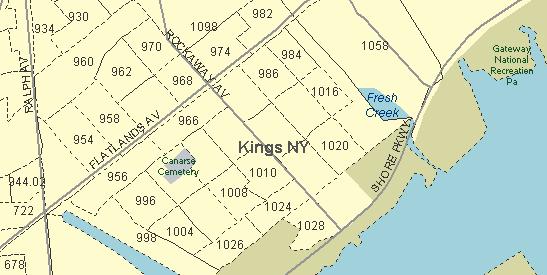
This map is the same but this time, it shows the Chinese population in my neighborhood. I felt this especially significant as to which culture i feel more closely to.
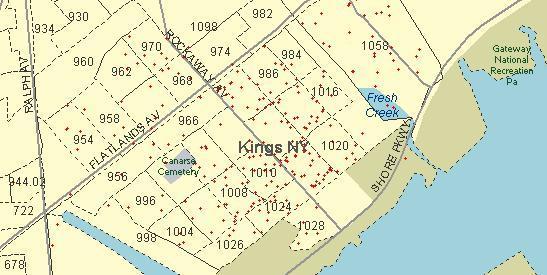
Here is some basic statistical information about my neighborhood.
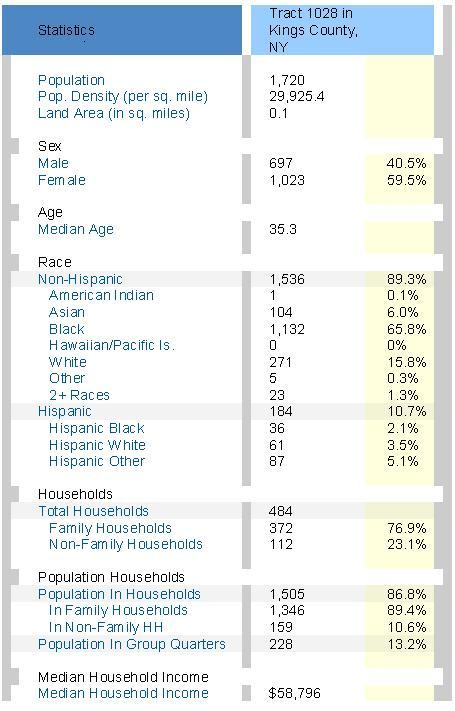
Analyzing this data, it is easy to understand why I don't feel as close to my neighborhood as others may in terms of culture. Only about six percent (104 people) are asian. Even less are Chinese and as seen in the first map, almost none are Taiwanese.
These are the age ranges of my neighborhood.
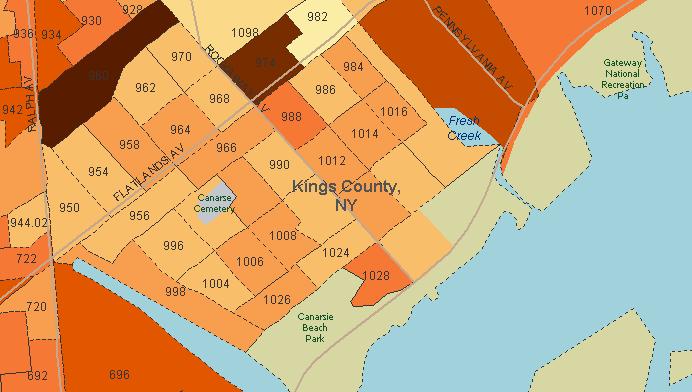
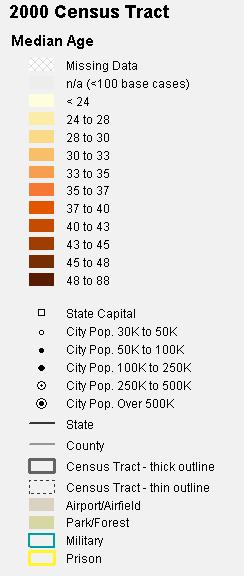
By analyzing the map and data, it can be concluded that the average age for my neighborhood is 28-37. Personally, I can attest to it as there are very few people around my age that I can call my peers.
This last set of map and legend show the poverty level in my neighborhood.
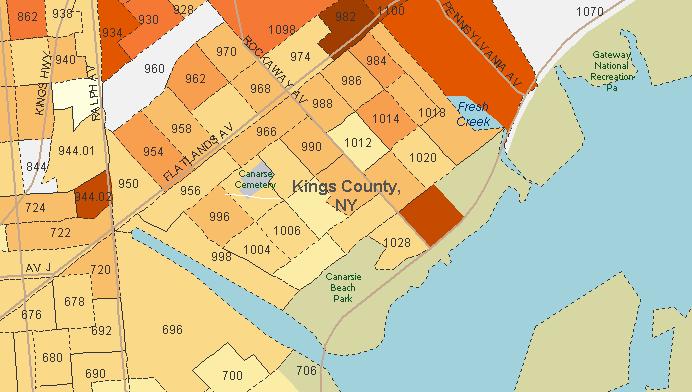
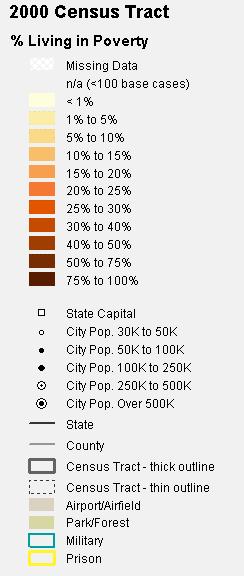
By analyzing the map and data, it can be concluded that there is, in general, only about a 5%-15% poverty rate dispersed around different parts of Kings County. The data disproves common beliefs, even my own initial belief, that my neighborhood was highly impoverished. Compared to the dges of the map, where the color is much darker, Kings County light colors show that it is generally better off than most of its neighboring counties.